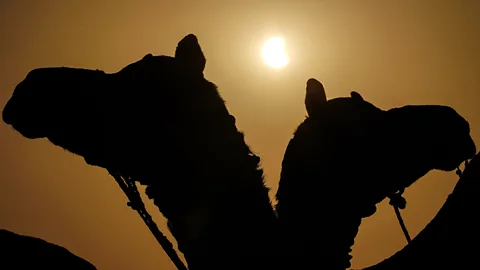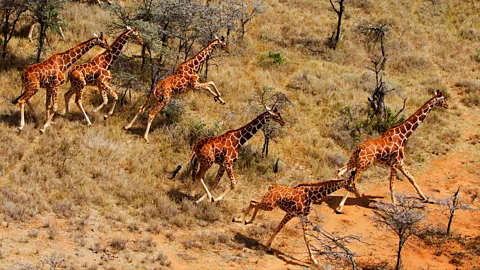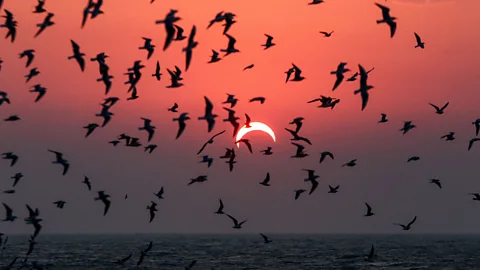Why some animals get agitated during a solar eclipse
 Getty Images
Getty ImagesHumans experience awe in the face of solar eclipses – but how do the other members of the animal kingdom feel when the day briefly turns to night?
On very special occasions, when the conditions perfectly align, the Moon conceals the Sun and blackness sweeps across the sky.
Although total solar eclipses only last for a few fleeting moments, they can have profound effects on humans, inspiring feelings of awe and wonder. But it's harder to predict how animals will respond when they are plunged into darkness in the daytime.
Animals rely on a 24-hour biological clock, known as their circadian rhythms, to control daily behaviours such as sleeping, foraging and hunting. The way eclipses disrupt these ingrained routines is relatively unexplored, as cosmic events are such rare phenomena – occurring in any given place roughly once every 400 years – and also, because not all animals react the same.
"[Light] is such a huge cue that affects everything from plants to animals. As biologists we can't turn off the Sun but every now and then, nature turns it off for us," says Cecilia Nilsson, a behavioural ecologist at Lund University in Sweden.
More than 100 years ago an entomologist from New England put the Sun's disappearance to the test. William Wheeler circulated adverts in local newspapers, recruiting the public to record changes in animal behaviour during a 1932 solar eclipse. He gathered more than 500 anecdotes, which charted changes in birds, mammals, insects and plants, including owls starting to hoot and bees returning to their hive.
 Getty Images
Getty ImagesIn August 2017, an eclipse which blotted out the Sun's rays for two minutes and 42 seconds, allowed scientists to repeat this experiment. This time, the spectacle had more surprising results. As darkness approached, giraffes galloped nervously and tortoises mated in a South Carolina zoo, and bumblebees stopped buzzing in the states of Oregon, Idaho and Missouri.
With the next solar eclipse taking place on Monday (8 April), curiosity has been piqued once again. Spanning a narrow strip of land, from Mexico to Maine, scientists will be watching the path of totality closely, and calling on people to note down any mysterious behaviour.
'The zoo was bonkers that day'
Adam Hartstone-Rose, a scientist who works with the Riverbanks Zoo and Garden in South Carolina, initially thought the zoo's inhabitants would be unfazed by the 2017 eclipse – shrugging it off like clouds passing or a rainstorm, he says.
Despite this, trained researchers and hordes of citizen scientists gathered at the zoo to observe 17 species before and after the eclipse. "It was remarkable because the zoo was bonkers that day. There were thousands of people, everybody was excited," he says.
More than three-quarters of animals that were observed had a discernible reaction to the "amazing" and "life-changing" event, says Hartstone-Rose.
The medley of reactions were categorised into four traits – animals who acted normally, those who performed their evening routines and those displaying anxiety or novel behaviours.
Some animals, such as grizzly bears, were totally nonplussed about experiencing a rare cosmic event. "They were basically sleeping and chilling during the whole experience," says Hartstone-Rose. "Right at totality one of them flopped his head over, almost to emphasise that he couldn't care less," he adds.
Nocturnal birds, on the other hand, seemed very confused. "During the daytime, tawny frogmouths try their best to look like a rotting tree stump," says Hartstone-Rose. The master of disguise, these birds shake their camouflage off at night to forage for food. "That's exactly what they did just at the peak of totality. When the Sun came back out, they went back into tree branch mode," adds Hartstone-Rose.
 Getty Images
Getty ImagesSadly, some animals showed symptoms of anxiety and distress during the eclipse. Giraffes, which are "usually pretty relaxed animals", says Hartstone-Rose, began running as if startled by a predator or vehicle in the wild. This mirrored giraffes at the Nashville Zoo in Tennessee, which grew nervous and began galloping after totality.
But the strangest behaviour came from the Galapagos giant tortoises. "Normally, tortoises are pretty sedentary and not very expressive animals," says Hartstone-Rose. However, they became more extroverted and active leading up to the eclipse – spontaneously mating with each other at the peak of totality.
Although the zoo was a unique environment to see a microcosm of different animals responding to the eclipse, there were drawbacks. "An eclipse is exciting and so people were being very loud and boisterous," says Hartstone-Rose. One limitation, particularly for the distressed animals, was whether they were reacting to the eclipse or the spectacle of humans reacting to the eclipse, he says.
In the wild
A more data-driven approach was to harness data from some 143 weather stations, stretching from the east coast to the west coast of the USA.
"We have this network that is always watching the sky, which is such a great opportunity to investigate these really rare events over large scales," says Nilsson, who led the study.
Scientists wondered if flying animals, such as birds and insects, would flock to the sky, mistaking the change in light with sunset. However, it's hard to spot birds taking flight through the darkness of the eclipse – which is where weather stations come into play.
"Instead of tracking individual birds, we get an overall measure of the amount of biological material in the air," says Nilsson.
A simple radar sends out a signal and then it measures the return like a sonar, resulting in a value called reflectivity. A large rain cloud or a small bird will have varying profiles of reflectivity, says Nilsson.
At sunset, activity in the sky usually peaks, as birds begin their night-time migration. But would an abnormal period of darkness in the middle of the day act as an environmental cue?
"What we saw was actually a decrease in the amount of birds in the air," says Nilsson. Most birds landed or stopped flying around in the lead up to the eclipse.
One theory was that their behaviour was analogous to a storm approaching, where birds seek shelter, she says.
Secondary-effects
Over in the Platte River Valley in Nebraska, which is a critical nesting site and a stopover point for migratory birds, it was easier to single out behavioural trends in the 2017 eclipse.
A team of scientists set up a series of time-lapse cameras and sound recorders along nature trails to monitor wildlife.
 Getty Images
Getty ImagesHowever, birds reacted in diverse ways, says Emma Brinley Buckley, a researcher from the University of Nebraska at Kearney. At 95% per cent obscuration, calls from western meadowlarks hushed or at some sites stopped altogether. On the flipside, American goldfinch and song sparrows ramped up their calls during totality, she says.
More like this
Just like humans, animals react to eclipses in different ways. In some studies, fish have sought shelter and spiders have destroyed webs as totality approaches. In a more recent experiment, where tiny microphones were suspended among flowers, bumblebees stopped buzzing when cast into darkness.
But we can't attribute all the change to light, as there are secondary effects that arise from a total eclipse, says Brinley Buckley.
In Nebraska, the temperature dropped by around 6.7 degrees Celsius (12F) and humidity climbed by 12% – a drastic change for a short time frame.
"We have a reduced solar illumination that resulted in ambient temperature declines and that's compounded by the changes in wind," she says. In essence, it's difficult to nail down the exact driver of change.
Get involved
This April, the Riverbank Zoo in South Carolina will be scaling up their monitoring with an even bigger citizen science study. "Some people want to do this very quietly and on their own, some people might want to do this with their friends, or some might want something to contribute to," says Hartstone-Rose.
The Solar Eclipse Safari project is encouraging thousands of people to observe animal behaviour – although they'll be looking beyond zoos, to include farm animals and pets.
Preliminary data has already been gathered from an annular eclipse in October 2023. Unlike a total solar eclipse, an annular eclipse is when the Moon only partially blocks out the Sun, creating what some people call a "ring of fire" effect.
Nasa is also running an Eclipse Soundscapes project with nearly 1,000 data collectors scattered across the US. Participants can use tiny data recorders called AudioMoths, which are about the size of three AA batteries. These audio data recorders will pick up sounds from wildlife during the eclipse.
"We're particularly looking out for if sounds have a lingering effect [on animals]" says Henry Trae Winter, a solar physicist at the Advanced Research in Steam Accessibility Lab. (Steam is an acronym for science, technology, engineering, arts and mathematics.)
The way animals respond to unusual stimuli could tell us more about human-induced disturbances, says Winter. "You could hear the effect of loud sounds in an area due to logging, or construction sites where lights stay on all night."
This is the last total solar eclipse visible from the United States until 2044 – so many people will be keeping their eyes peeled on the animals too.
"Any eclipse is an amazing and powerful shared experience that we have with each other and with the natural world. It's when we can go out and think about broader questions," says Hartstone-Rose.
--
If you liked this story, sign up for The Essential List newsletter – a handpicked selection of features, videos and can't-miss news delivered to your inbox every Friday.
